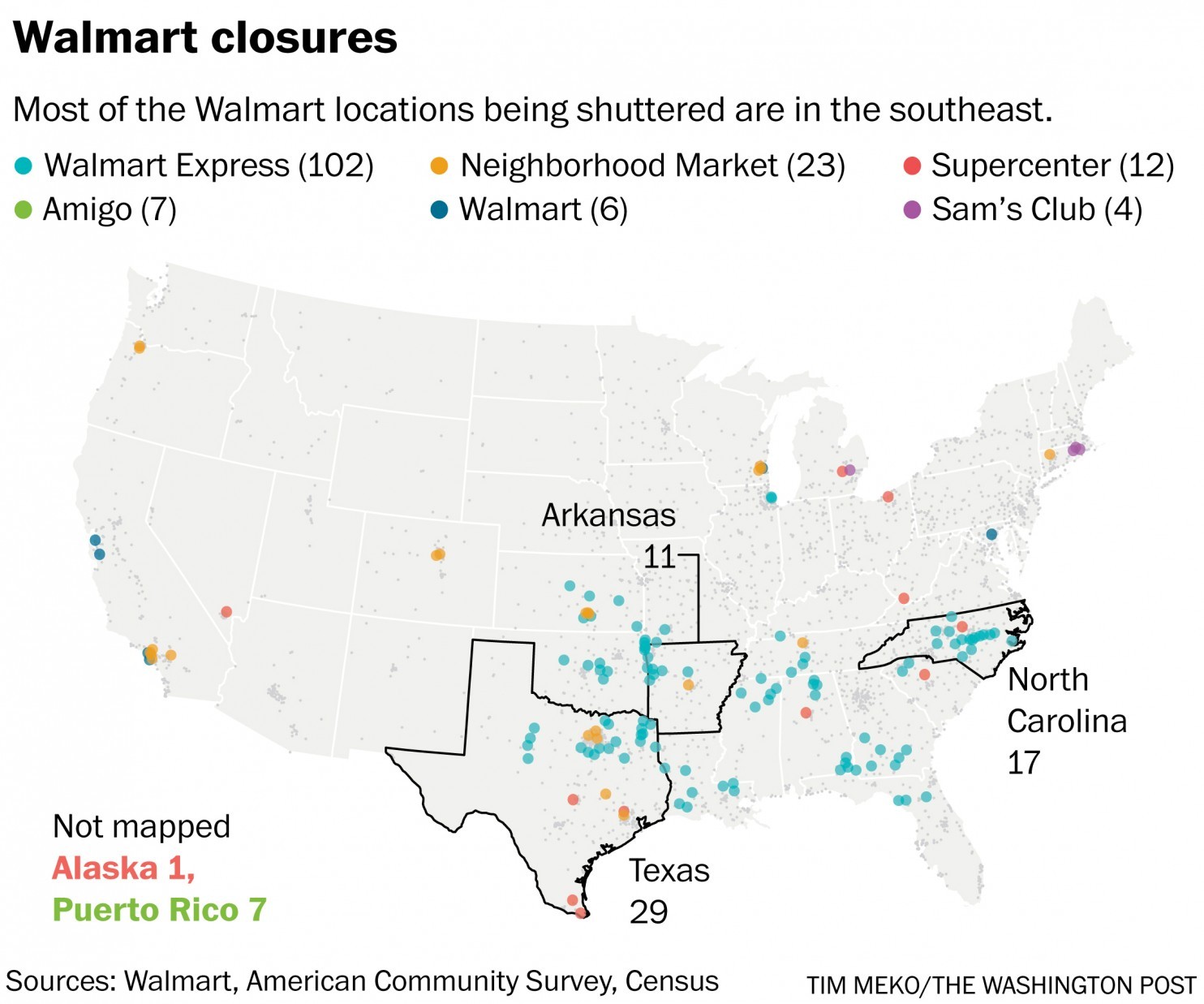 ONCE DEMONIZED AS DOWNTOWN-KILLING MACHINE, A NOW-OVEREXTENDED WAL-MART'S RETREAT FROM SMALL-TOWN AMERICA WILL EXTINGUISH THE MOST VULNERABLE COMMUNITIES. Many small towns give up the ghost when they lose their local hospital, a sure sign that there's no longer enough local dollars to sustain a high-priced facility and its personnel. But when big-box, rock-bottom-prices Wal-Mart gives up on your town, it's actually far worse, because now the people with the least disposable income - and often no car - are now locked out of their primary source of just-getting-by consumption. Stand outside a Wal-Mart sometime and see who walks up (sans car), or bikes there, or is forced to take a bus or taxi to the store, only to come out an hour later with bags of virtually everything they'll consume over the coming weeks, and you'll be looking at the most vulnerable of the 99 percent in America. Because, when Wal-Mart pulls up stakes within their small universe, they've got nowhere else they can go for anything close to the same buying power (and no, the truly vulnerable don't shop much online).
ONCE DEMONIZED AS DOWNTOWN-KILLING MACHINE, A NOW-OVEREXTENDED WAL-MART'S RETREAT FROM SMALL-TOWN AMERICA WILL EXTINGUISH THE MOST VULNERABLE COMMUNITIES. Many small towns give up the ghost when they lose their local hospital, a sure sign that there's no longer enough local dollars to sustain a high-priced facility and its personnel. But when big-box, rock-bottom-prices Wal-Mart gives up on your town, it's actually far worse, because now the people with the least disposable income - and often no car - are now locked out of their primary source of just-getting-by consumption. Stand outside a Wal-Mart sometime and see who walks up (sans car), or bikes there, or is forced to take a bus or taxi to the store, only to come out an hour later with bags of virtually everything they'll consume over the coming weeks, and you'll be looking at the most vulnerable of the 99 percent in America. Because, when Wal-Mart pulls up stakes within their small universe, they've got nowhere else they can go for anything close to the same buying power (and no, the truly vulnerable don't shop much online).From a powerful WAPO story on the subject:
To hear Mary Francis Matney tell it, Walmart didn’t kill the once-vibrant cluster of shops next to a railroad and a creek in the faded old coal town of Kimball, W. Va. — the disappearance of the mines had pretty well taken care of that already. But now that Walmart’s leaving, too, as one of 154 U.S. stores the company closed in January, the town might be snuffed out for good.
“It makes everyone so downhearted they don’t know what to do,” said Matney, 60, browsing the half-empty shelves of Kimball’s massive Supercenter, leaning on her cart, which contains a dustbuster and door crack insulation. Her husband once worked in the coal mines. Now the couple lives on what little they get from Medicare and Social Security, and with precious few other options she made the hour-and-a-half trip from her home back in the “hollers” once a month to stock up.
“It’s like we’re a forgotten bunch of people,” said Matney, her long gray hair loosely clipped into a bun. “It’s about all there was to look forward to. If we had to go any further, there ain’t no way.”
She patted the metal shelves full of half-off merchandise affectionately. "I hate seeing it die. I really do,” she said. “You could always find better stuff here.”
And two days later, the store was gone.
Wal-Mart just announced it was closing a slew of such "underperforming" stores across the United States, and - big surprise, "a Washington Post analysis of the stores on the closure list shows that they are in relatively lower-income, less dense census tracts." That's the truth of poverty in America: in terms of sheer numbers, it is far more an isolated rural phenomenon than one of the inner-city.
The repercussions of a Wal-Mart closing are many:
In Raymondville, Texas, the disappearance of tax income from Walmart could force city layoffs. In Oriental, North Carolina, the arrival of a Walmart Express had been the final straw for a local grocery store, leaving the community with few options for food — also the case in Fairfield, Ala. and Winnsboro, S.C.
Wal-Mart has never pulled back like this before, essentially killing its entire "Express" convenience store pilot program - the primary way it was going to serve the under-served throughout the country.
In many ways, this is one of those "other shoes" that finally dropped from the Global Financial Crisis and the years-long Great Recession it spawned. Wal-Mart is simply trimming back from an over-saturation strategy that decimated the competition and now leaves plenty of those 99%-communities high and dry.
The many negative ripples are still to be felt:
But Walmart’s disappearance will have more subtle ripple effects, like a drop in traffic to the small neighboring hotel and gas station, and the loss of a place to buy phone cards and hire tax preparation help. It was the main donor to the local food bank, and contributed $65,000 annually in taxes to the county, most of which goes to the school district.
And that's why the 99% continue to exhibit profound political anger in this unfolding presidential election. They feel their personal, family, and community resilience being sapped by economic forces beyond their control, and they desperately want Washington to give a damn about their plight.